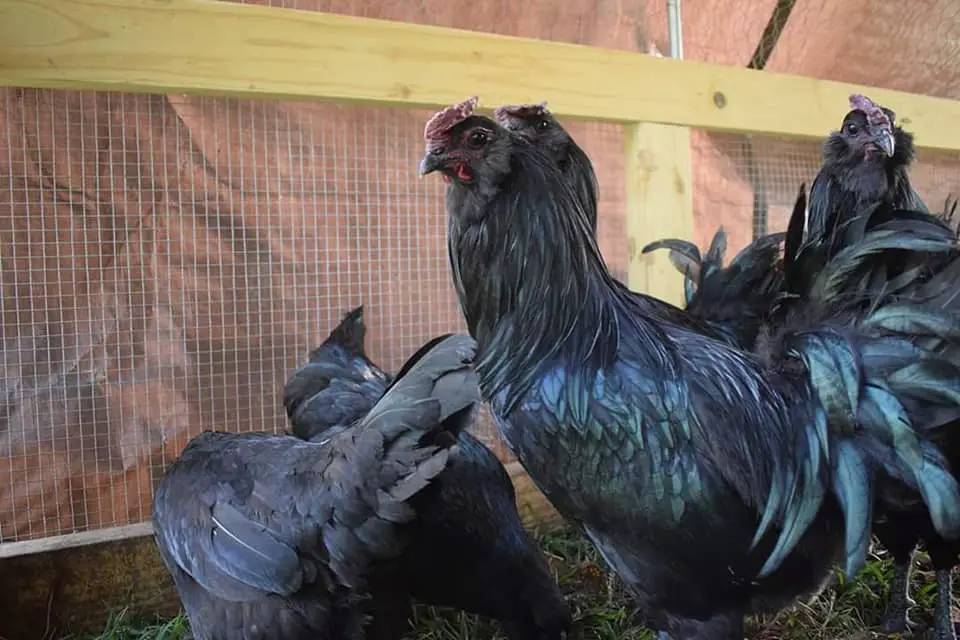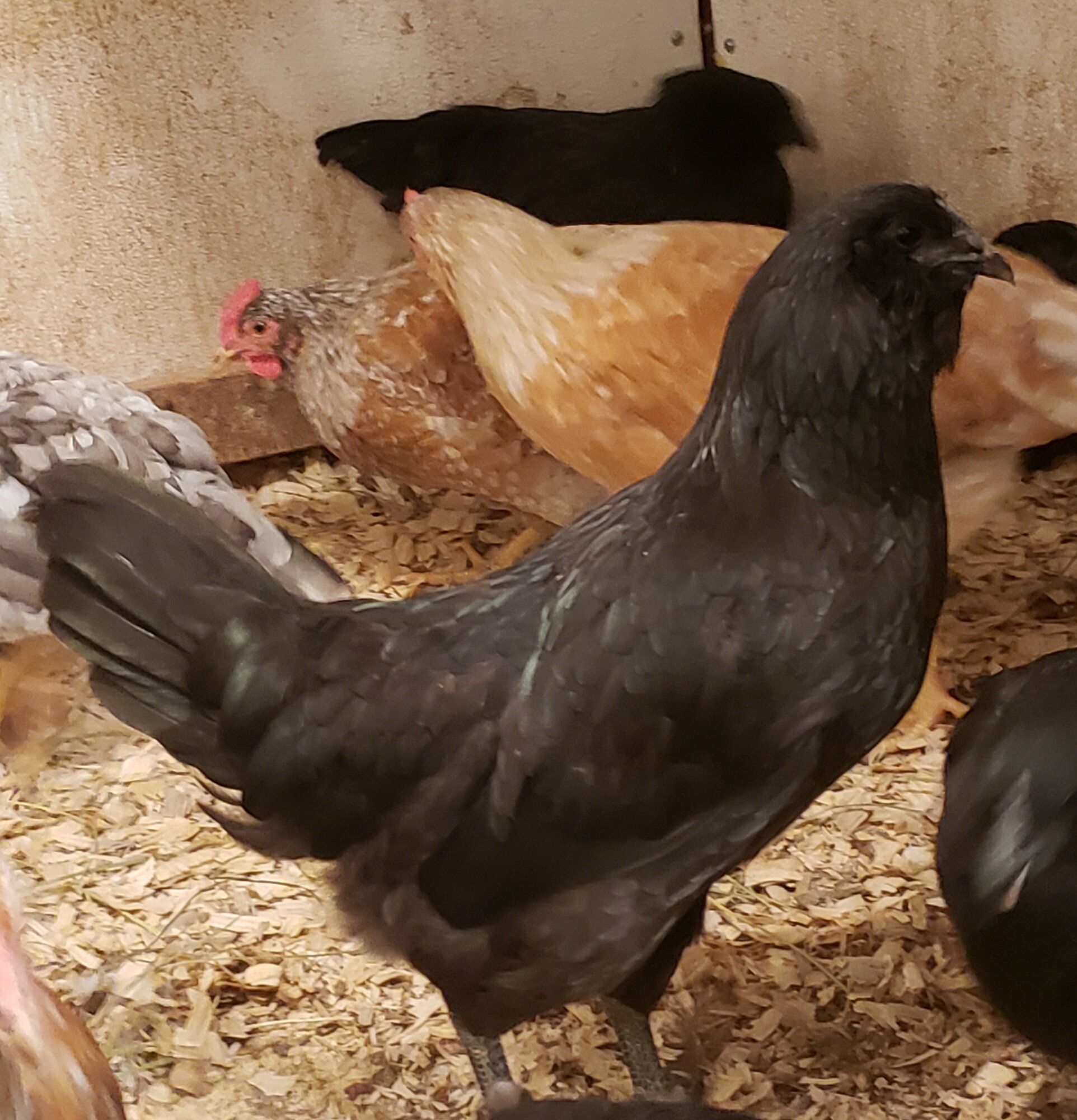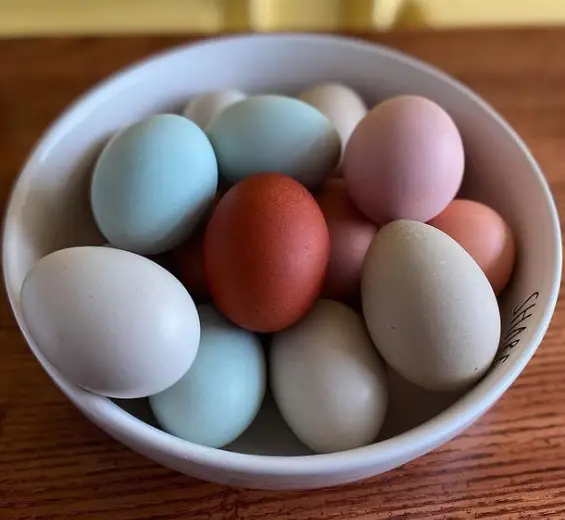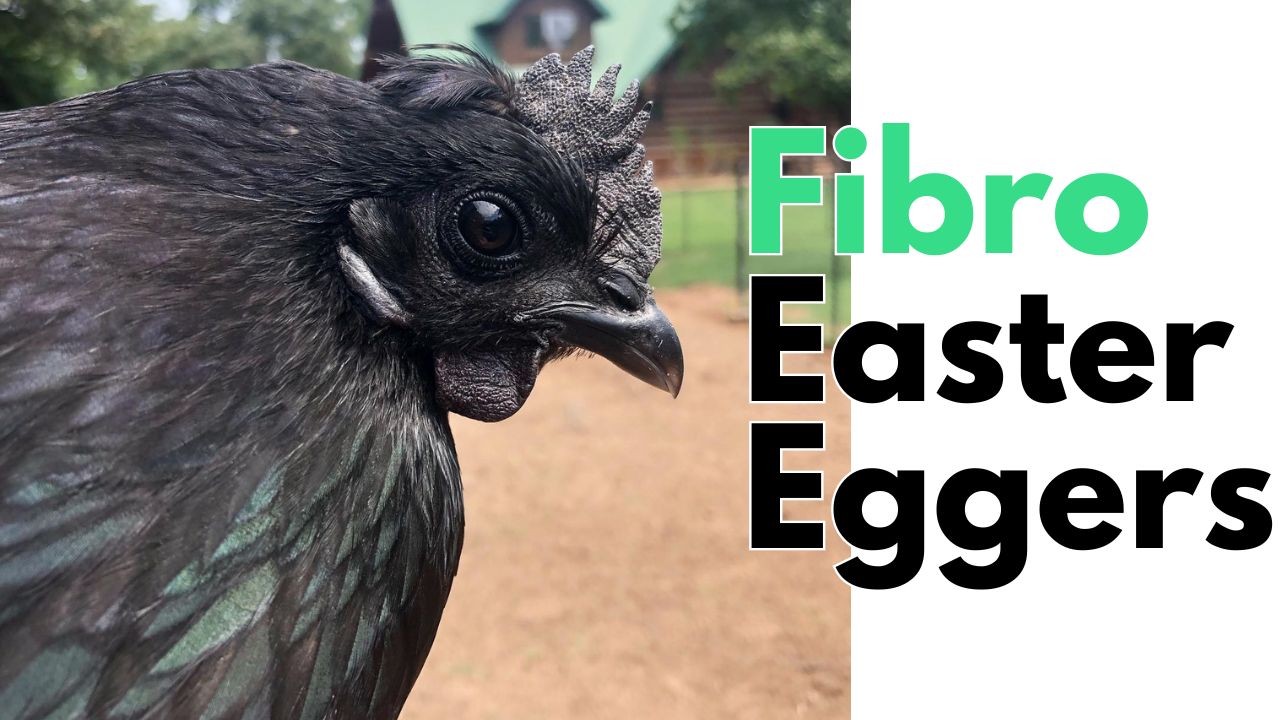Fibro easter eggers are hybrid, dual purpose, almost all black and laying colorful eggs, hardy and docile by nature.
This article discusses the profile and fascinating facts about the interesting chicken’s fibro easter eggers.
Let’s dive deep.
Quick Overview
|
Hybrid |
Yes |
|
Type |
Standard Large Fowl |
|
APA Class |
Not Recognized |
|
Purpose |
Dual Purpose, Ornamental |
|
Uniqueness |
Ear Muffs & Beard |
|
Rarity |
Common (Color Variety) |
|
Legs |
Black |
|
Feather on Legs |
No |
|
Skin Color |
Black |
|
Eggs Eggs Per Year |
200-230 |
|
Egg Color |
Blue, Green, Pink |
|
Egg Size |
Medium/Large |
|
Chicken Weight |
4-6 lbs |
|
Hardiness |
Cold and Heat |
|
Temperament and Personality |
Docile, Friendly, Calm, Sweet & Fun Chickens |
|
Chicken Color |
Black with secondary colors |
|
Broodiness |
Occasionally |

What is a Fibro Easter Egger
A Fibro Easter Egger is a hybrid breed famous for its colorful eggs and unique appearance. They get their name from the Fibro melanistic gene, causing pigmentation in the skin and feathers.
The fibro easter eggers is an interesting breed of chicken and a part of a special group known for Fibromelanosis chickens, which means it has dark feathers, skin, or features.
Fibro Melanistic is a genetic change that increases the amount of melanin in chickens (those with more melanin will be darker).
With Fibro Easter Eggers, the amount of black feathers can be different, as can the other colors, but their skin, legs, and earlobes are always black.

From where did Fibro Chickens Come?
Fibro chickens come from the gene fibromelanosis which causes an excessive amount of melanin to accumulate in the skin and connective tissues of the chicken.
Fibro Melanistic is a genetic change that increases the amount of melanin in chickens, resulting in darker pigmentation. The more melanin present, the darker the chickens will appear.
The fibromelanosis gene is dominant and becomes highly visible when hyper-pigmented males are bred with females of regular pigmentation. In such pairings, offspring can inherit the dark hyperpigmentation seen in their fathers.
Through careful selection of the darkest chicks and mating them with other fibro melanistic birds over multiple generations, breeders gradually achieve more consistent and reliable coloring.
Interestingly, this breeding approach can produce hybrids like the Fibro Easter Egger, which displays the fibromelanosis trait.
The gene responsible for the black coloration in fibro-melanistic chickens is believed to be dominant. However, the extent of “blackness” in each bird can vary because the gene may not always be fully expressed.

Fibro Easter Eggers Colors and Appearance
Their unique look and color make these chickens stand out from other chickens. They don’t have a topknot but have beautiful muffs and beards.
Their skin, legs, and earlobes are either black or have black spots, while the amount of black feathers they have may vary.
Along with their distinctive coloring, the Fibro Easter Egger also has clean-looking black legs and black beaks.
Fibro Easter Eggers Temperament
Fibro Easter Eggers are usually known for their friendly, gentle, and active personality. Because they are so calm, sweet and sociable.
They are active and excellent foragers who love to explore their environment and prefer to roam freely.
Fibro Easter Eggers are an excellent option for people new to raising chickens, as they’re friendly, sociable, and energetic birds.
They are also seen as great buddies, loved for their cute ways, friendly personalities, and colorful egg-laying ability.
Fibro Easter Eggers Eggs
Fibro Easter Eggers are renowned for their prolific egg-laying abilities, providing a bountiful supply of colorful eggs.
They usually start laying eggs when they’re about 5 to 6 months old, around 24 weeks. Their eggs can be either medium or large.
They lay about 200 to 230 eggs a year, which is around 4 eggs per week. The eggs come in green, blue, and sometimes pink or brown colors.
Remember, a few Fibro Easter Eggers might lay white or cream-colored eggs.

Engrossing Facts about Fibro Easter Eggers chicken
Some fascinating facts about Fibro Easter Eggers:
- Colorful Eggs
Fibro Easter Eggers lay colorful eggs like blue, green, brown, and pink. This makes their eggs stand out and adds a vibrant touch to any egg basket.
- Fibro Melanistic Gene
These chickens have a gene called fibro melanistic, which makes their skin, muscles, and feathers very dark in color. That’s why they often look dark overall.
- Hardy and Adaptable
Fibro Easter Eggers are hardy and can handle different weather and places well. Whether it’s hot and humid or cold and dry, these chickens usually do well and stay healthy.
- Friendly/Sweet Temperament
These chickens are calm and nice, which makes them perfect for backyard groups of chickens. They usually like being around people and can be very friendly.
- Mixed Breed Origins
They’re not a standard breed, but instead, they’re a mix of different chicken breeds. This mix is what makes them look so different and gives them a varied genetic makeup.
- Popular Among Hobbyists
Fibro Easter Eggers are popular choices among chicken keepers and hobbyists, as they have a unique look, friendly and docile personality, and lay colorful eggs.
Fibro Easter Egger Price
Meyer Hatchery created this hybrid chicken, and you can exclusively find the Fibro Easter Egger there.
The cost of a Fibro Easter Egger chicken can vary based on factors like its age, family history, color, and whether it’s a chick or an adult bird.
However, at Meyer Hatchery, day-old Fibro Easter Egger chicks cost around $20. Prices might change depending on local demand and availability.
Fibro Easter Egger Hatching Eggs
How to Care for Fibro Easter Eggers
Ensuring the health and productivity of your fibro easter eggers chicken requires proper care and attention.
Here are the basic needs and care requirements:
-
Housing for Fibro Easter Eggers
Making sure your chicken coop is comfortable, well-built, ventilated, and safe from predators is crucial.
You should give each chicken at least 2 to 3 square feet of space in the coop, and about 8 to 10 square feet of space outside for moving and exploring.
Try to clean and dry the coop at least twice or thrice a week and make sure to dry the coop after wetting them.
Provide nesting boxes filled with clean and soft straws to lay eggs and collect eggs daily to prevent wasting and dirtiness.
-
Nutrition
Give your Fibro Easter Eggers a balanced diet, including commercial feed, to meet all their nutritional requirements.
Adding fruits, vegetables, and occasional treats to their diet, to keep them happy and active. Ensure access to clean and fresh water all the time.
Make sure to avoid any harmful food like chocolate, avocado skin or pit, coffee or tea, apple seeds, raw potatoes, green potatoes, onions, garlic, or raw eggs.
-
Health Care
Regularly checking for signs of illness and injuries and seeking advice from a veterinarian will help maintain their health and well-being.
Provide needed vaccination and deworming as recommended by the veterinarian and keep their surroundings and their coop clean to prevent microorganisms and infections.
Make sure to give your Fibro Easter Eggers a chicken friend so they don’t feel lonely and to prevent any mental issues.
-
Maintenance
Regular maintenance is essential to keeping chickens healthy, happy, and gorgeous.
Trim any stray and unnecessary feathers and nails to prevent them from becoming overgrown, which could cause mobility and vision problems.
Make sure to provide clean and dry soil in their surroundings for dust baths. Dust baths help regulate oil production and keep their feathers healthy.

Final Thoughts
In conclusion, fibro easter eggers are a type of hybrid chicken named after the Fibromelanosis gene, which causes dark pigmentation in them. These chickens are well known for their unique appearance and their ability to lay eggs in various colors.
Fibro easter egger day old chicks are exclusively available at Meyer Hatchery. They come in females, straight run, and males. You can easily get them there for your flock or backyard.
Feel free to share your thoughts and concerns with us. We’d love to help you.
FAQs
Are easter eggers heat-tolerant?
Yes, easter eggers tolerate heat well.
How long do easter eggers lay?
Easter Eggers usually lay eggs for 3 to 4 years, but how long they lay eggs can change based on their genes, health, and where they live.
What are fibro easter eggers?
Fibro Easter Eggers are a type of chicken known for their colorful eggs and unique appearance. They’re called “fibro” because of a gene called Fibromelanosis, which causes darker pigmentation in their skin, and feathers.
At what age do fibro easter eggers start laying eggs?
Fibro easter eggers usually start laying eggs when they’re about 5 to 6 months old, around 24 weeks.
What color eggs do fibro easter eggers lay?
Fibro easter eggers produce eggs in various colors like green, blue, and sometimes pink or brown colors.
Are fibro easter eggers friendly?
Yes, they are known for their sweet, docile, and friendly disposition.
Do fibro easter eggers have black feathers?
Yes, fibro easter eggers have black feathers due to fibromelanosis, a genetic condition that results in black pigmentation.
Do fibro easter eggers have feathered feet?
No fibro easter egger has full clean and black feet.

